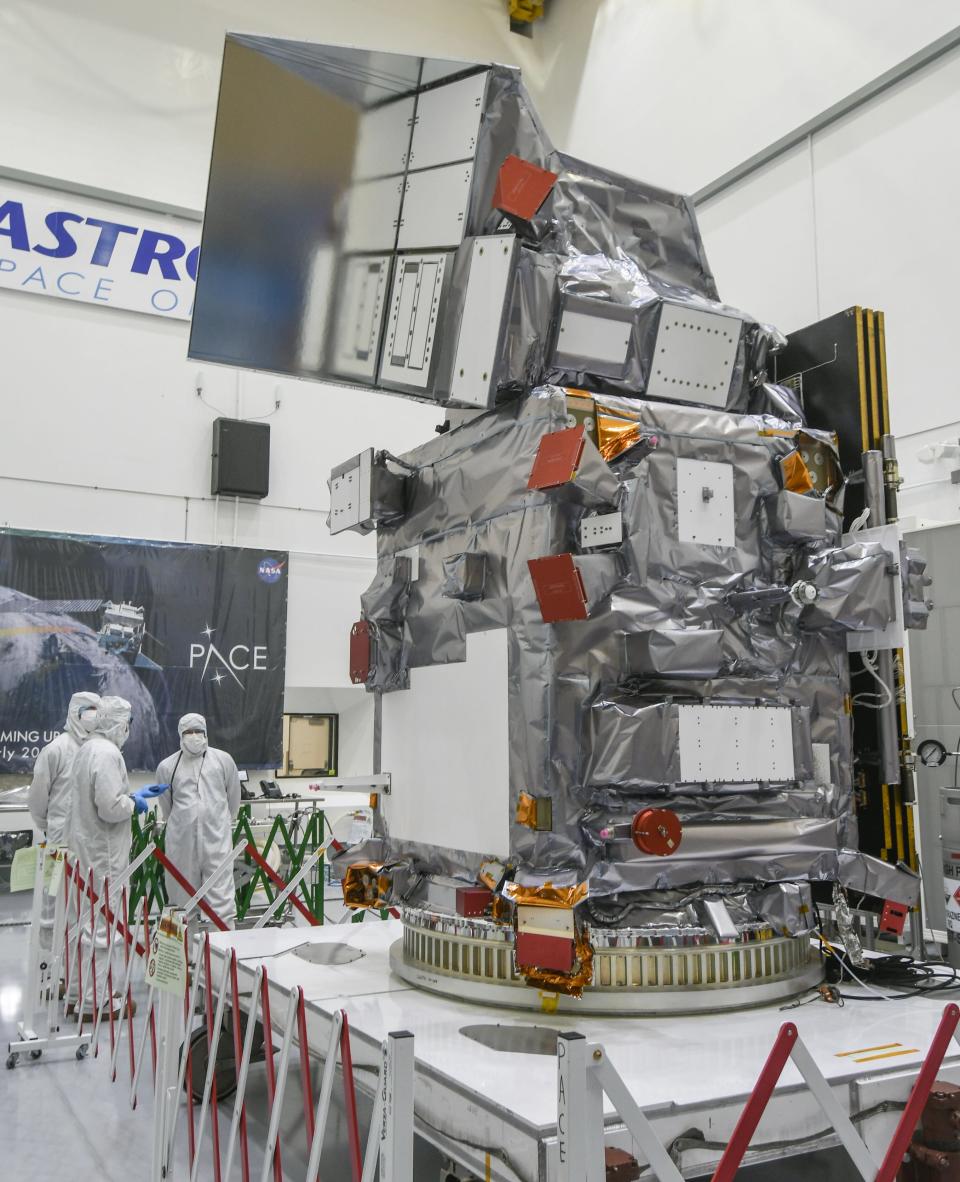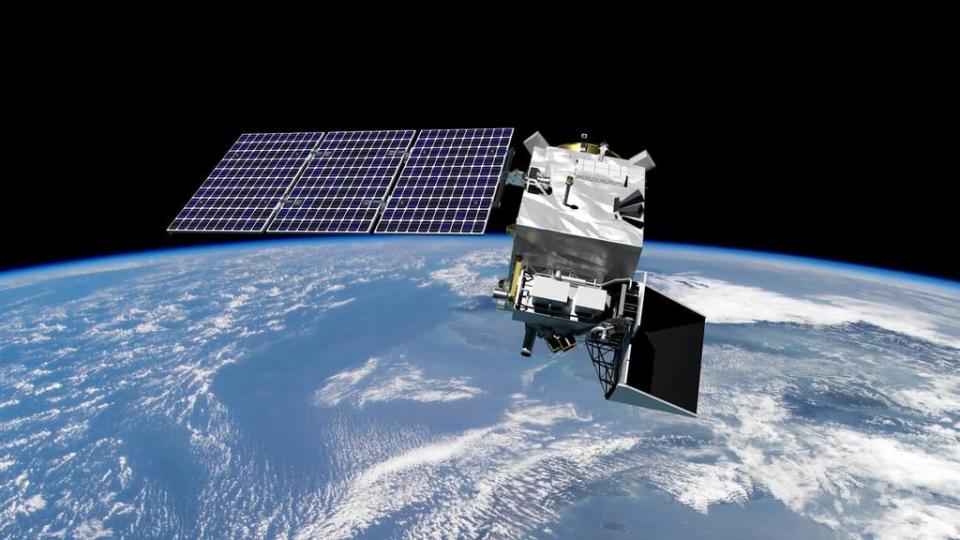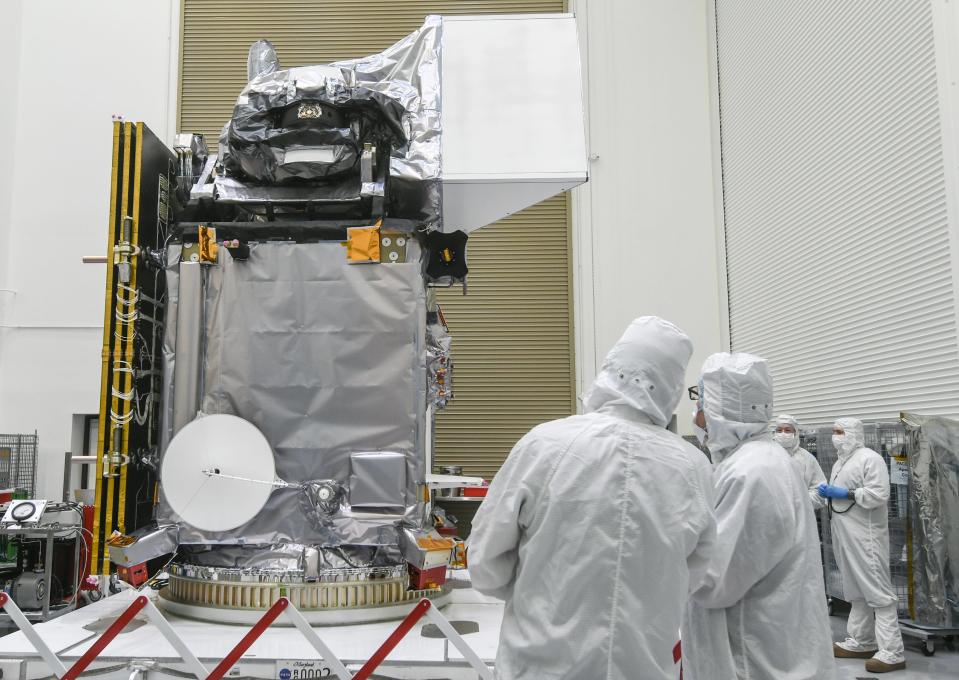Take a peek at NASA's PACE spacecraft, which will study climate change and ocean health
An advanced NASA spacecraft designed to study Earth's oceanic and atmospheric phenomena waits behind an airlocked door inside an environmentally controlled Titusville high bay, where white-suited technicians plan to start adding rocket fuel next week.
NASA's PACE observatory — an acronym for Plankton, Aerosol, Cloud, ocean Ecosystem — arrived Nov. 15 at Astrotech Space Operations off Grissom Parkway. In orbit, PACE will gather "immense quantities of data" on the chemical composition, movement and interaction of airborne particles and clouds by scanning Earth with polarimeters every two days, NASA said.
"They measure light a little bit differently — they have polarized sunglasses on. So you're not only seeing total intensity, like your eyes do. But you are seeing how vertical photons, or vertical energy, and horizontal energy actually change," said Jeremy Werdell, a NASA PACE project scientist.
"And if you had polarized eyes, the world would look wildly different. So it's a really unique way to observe our home planet," Werdell said.

NASA and SpaceX are targeting Feb. 6, at the earliest, to launch PACE into orbit from a SpaceX Falcon 9 rocket at Launch Complex 40 at Cape Canaveral Space Force Station.
"It's the first government polar orbit (launch) from the East Coast since 1960. SpaceX has done it 11 times for commercial customers, but this is the first government one. We usually do Vandenberg for polar orbits," Creg Raffington, a NASA mission manager, told reporters during a Wednesday PACE media event at Astrotech.
Estimated total lifecycle cost of PACE: $948 million.
"The reason that I have a ton of energy — and a ton of nausea — is we've been talking about this for over two decades. And now we're, what, less than a month from launch," Werdell said.
Gauging air quality and ocean health

PACE data should help scientists understand how the ocean and atmosphere exchange carbon dioxide; gauge air quality and Earth’s climate; and monitor ocean health by studying phytoplankton, a NASA press release said. Primary instruments on board:
OCI (Ocean Color Instrument), a hyperspectral imaging radiometer developed by NASA's Goddard Space Flight Center.
HARP2, a polarimeter developed by the University of Maryland, Baltimore County.
SPEXone, a polarimeter developed by the Netherlands Institute for Space Research and Airbus Defence and Space Netherlands.
Werdell said PACE data will help analyze dust storms, Canadian wildfire smoke and harmful algal blooms. Addressing the media, he displayed an aerial photo of the 2011 algal bloom that struck western Lake Erie — alongside a glassful of murky green lake water.
"This is the kind of event that has real societal relevance. Because it contaminates drinking water. It's a nuisance for homeowners, so it changes the economy. It closes shellfisheries. So we are in the grand search for both beneficial and nonbeneficial phytoplankton," said Werdell, who is an oceanographer.
Werdell said PACE will generate so much unprecedented data that researchers are considering how to employ machine-learning techniques to analyze it. He added, "this is the first mission in my 25 years at NASA that I can grow into scientifically."
"If you think of the leap from Hubble to James Webb, we're going to experience that same kind of leap in our science. It's that profound," he said.
Close encounter with PACE spacecraft

About 20 photographers and reporters were invited to enter the airlock for a rare glimpse of the PACE spacecraft inside the Astrotech high bay.
First, media members donned blue hairnets, white face masks and black shoe booties before garbing up in white head-to-toe clean-room suits. Contamination-control specialists taped sleeve cuffs onto gloved wrists, sealing dust and skin particles inside to protect the sensitive spacecraft.
Perfume, hair spray, makeup, keys, watches, notebook paper, pens and pencils were prohibited in PACE's clean room.
"We put the observatory behind a filter bank of air, so there's always clean air passing across it to keep the optics clean. And all the personnel in the room wear what we call 'bunny suits' to keep any skin or anything else off the observatory," said Gary Davis, PACE mission systems engineer, standing alongside the spacecraft while wearing a bunny suit.
Soon, Davis said technicians will add hydrazine rocket fuel to the spacecraft's 235-kilogram internal tank. Afterward, crews will prepare PACE for launch.
"We'll remove all the protective covers that are covering the instruments and other sensors, button up our blankets, get everything ready for flight. And then with help from the SpaceX team, we'll encapsulate the observatory inside the fairing," Davis said.
"And then from there, it transfers over to Launch Complex 40, where it gets mated to the Falcon rocket," he said.

More: Rocket launch schedule: Upcoming Florida launches and landings
Rick Neale is a Space Reporter at FLORIDA TODAY (for more of his stories, click here.) Contact Neale at 321-242-3638 or rneale@floridatoday.com. Twitter/X: @RickNeale1
This article originally appeared on Florida Today: NASA PACE spacecraft to study climate change, pollution, ocean health

